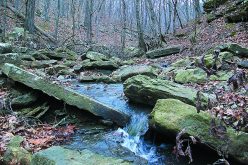
Amanda Bancroft
Making Ripples
There are countless ways that nature plays with light, even in darkness. Winter snow and ice reflect the moonlight, and stars look their brightest in winter. In the depths of the deep sea, cold caves, and dark forests, bioluminescence highlights the life that may otherwise go unnoticed. There is life thriving in even the most barren, hopeless landscapes (and the most uncertain new year).
As winter descends post-solstice, it’s nice to know that the stars are showier than usual, on a clear night, that is. One may wonder why the stars don’t seem as bright on June, July and August nights when the temperature is nice for comfortable stargazing. Freezing nights in December, January, and February offer the best view, ironically. Deborah Byrd of EarthSky radio explains that’s because in summer we’re looking towards the center of the Milky Way Galaxy, and there are so many stars that the view appears hazy. In winter, we’re facing towards the outside of the galaxy, with fewer, but brighter, closer stars and a backdrop of blackness in deep space.
Winter offers time for reflection and opportunities for light to reflect, too. According to the National Snow and Ice Data Center, “albedo” is a number that indicates how well a surface reflects solar energy. Zero is a perfect absorber, and one is a perfect reflector. Snow and ice combined have a score of 0.9! So when layered together, they can reflect about ninety percent of the sun’s rays. Even the moon, with a low albedo score of 0.12 because it’s a dark grey rock, reflects enough sunlight for it to appear luminous at night, and that light is scattered onto the snow and ice to produce a winter wonderland.
But wintry reflections aren’t the only lights in the darkness. The New Zealand and Australian cave glowworm (Arachnocampa luminosa) generates a mural of stars on cave ceilings as part of their predatory plan to capture lunch. They glow with a similar chemical reaction found in fireflies, by combining oxygen, luciferin, luciferase, and adenosine triphosphate. Glowworms and fireflies don’t have a monopoly on lighting up the dark, however.
Bioluminescence is used for a variety of purposes, including camouflage, communication, mimicry, defense and warning, and attraction. It’s found in fungi such as our native “honey mushroom” (Armillaria mellea) with mostly hidden glowing mycelium, and also marine life, like krill and the angler fish (which has a symbiotic relationship with bacteria).
Even ocean waters can appear to glow, due to either dinoflagellates (such as marine plankton) on the surface or bioluminescent bacteria covering thousands of miles and capable of being seen from space. That effect is still being researched, as there are a few mysteries left to solve. In short, our planet is brilliant!
Amanda Bancroft is a writer, artist, and naturalist building an off-grid cottage for land conservation on Mt. Kessler. She and her husband Ryan blog about their adventures and offer a solar-hosted online educational center on how to make a difference with everyday.










